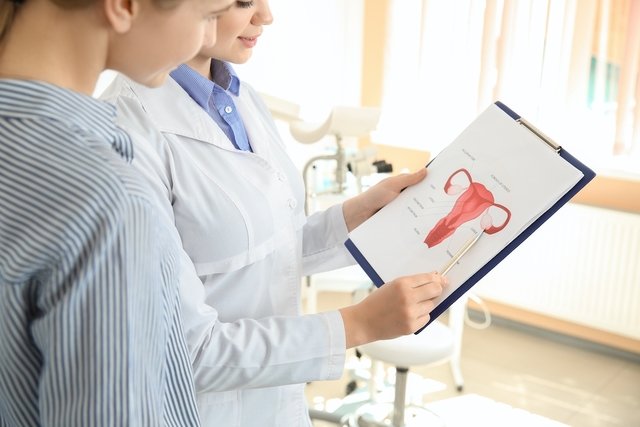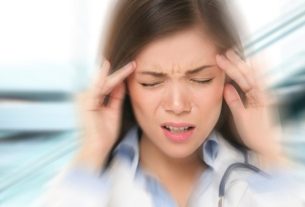A follicular cyst, also called a benign ovarian cyst or functional cyst, is a small fluid-filled sac located in the ovary, which can cause symptoms such as abdominal pain, a feeling of pressure in the belly and changes in menstruation.
This cyst is a type of ovarian cyst that appears when the ovarian follicle does not rupture to release the egg during the menstrual cycle, and is more common in young women of childbearing age. Understand better what an ovarian cyst is.
The follicular cyst usually disappears on its own within 6 to 8 weeks, without requiring medical treatment. However, if the cyst is very large, blocks the blood supply to the tubes or ovary, or ruptures, the gynecologist may recommend surgery.

Main symptoms
The main symptoms of a follicular cyst are:
- Pain or discomfort on one side of the abdomen;
- Sensation of pressure in the lower part of the belly;
- Vaginal bleeding outside the menstrual period;
- Heavy or long menstruation;
- Irregular menstrual cycles.
Although it is common for a follicular cyst to cause no or few symptoms, especially when the ovarian cyst ruptures or in the case of ovarian torsion, intense and sudden pain in the abdomen, nausea and vomiting may also occur.
Read too: 15 symptoms of ovarian cyst
Is a follicular cyst cancer?
A follicular cyst is not cancer and is considered a type of benign ovarian cyst. This cyst typically causes few symptoms and disappears on its own within 6 to 8 weeks.
Possible causes
The follicular cyst develops when the follicle, which is a structure present in the ovary that stores the egg, does not rupture to release the egg from its interior during the ovulation period, forming a pocket inside the ovary or on its surface full of liquid or blood.
This type of ovarian cyst is more common in case of a history of tubal ligation (tubal ligation), during the woman’s reproductive period and during pregnancy, especially in young women.
How to confirm the diagnosis
The diagnosis of a follicular cyst is made by a gynecologist through evaluation of symptoms, pelvic examination and results of imaging tests, such as ultrasound, computed tomography or magnetic resonance imaging.
Furthermore, as the follicular cyst can cause symptoms similar to those of other types of ovarian cyst, the doctor may recommend the CA 125 test, which helps identify cysts that may indicate ovarian cancer. Understand what the CA 125 exam is for.
Make an appointment with your nearest gynecologist, using the tool below, so that they can recommend the best tests to investigate the follicular cyst:
Taking care of your health has never been easier!
How the treatment is carried out
The follicular cyst usually disappears on its own, within 1 or 2 menstrual cycles, and does not require medical treatment. However, follow-up with the gynecologist and examinations should be carried out at intervals indicated by the doctor to verify its disappearance.
If the follicular cyst is large, causes symptoms or does not disappear, the doctor may recommend surgery to remove the ovarian cyst. Furthermore, in case of ovarian torsion or cyst rupture, surgery may also be indicated.
Can someone with a follicular cyst get pregnant?
A follicular cyst does not normally prevent a woman from getting pregnant, especially when it does not cause changes in menstruation. Furthermore, this cyst tends to disappear on its own within a few weeks.
Bibliography
- LEGENDRE, Guillaume et al. Relationship between ovarian cysts and infertility: what surgery and when?. Fertile Sterile. Vol.101, n.3. 608-14, 2014
- SCOB. Gynecology Manual of the Society of Gynecology and Obstetrics of Brasília. 2017. Available at: <https://www.sgob.org.br/2021/08/06/manual-de-ginecologia-da-sociedade-de-ginecologia-e-obstetricia-de-brasilia/>. Accessed on March 24, 2023
- ACOG. Ovarian Cysts. Available at: <https://www.acog.org/womens-health/faqs/ovarian-cysts>. Accessed on March 24, 2023
- American College of Obstetricians and Gynecologists’ Committee on Practice Bulletins—Gynecology. Practice Bulletin No. 174: Evaluation and Management of Adnexal Masses. Obstet Gynecol. Vol.128, n.5. e210-e226, 2016
- STATPEARLS. Ovarian Cyst. 2022. Available at: <https://www.ncbi.nlm.nih.gov/books/NBK560541/>. Accessed on March 24, 2023
- TELLECHEA, O.; et al. Benign follicular tumors. An Bras Dermatol. 90. 6; 780-96, 2015

Sign up for our newsletter and stay up to date with exclusive news
that can transform your routine!
Warning: Undefined array key "title" in /home/storelat/public_html/wp-content/plugins/link-whisper-premium/templates/frontend/related-posts.php on line 12
Warning: Undefined array key "title_tag" in /home/storelat/public_html/wp-content/plugins/link-whisper-premium/templates/frontend/related-posts.php on line 13



